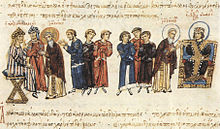John VII of Constantinople
John VII of Constantinople | |
|---|---|
| Ecumenical Patriarch of Constantinople | |
 The embassy of John VII in 829, between Emperor Theophilos (right) and Caliph Al-Ma'mun, from the Madrid Skylitzes | |
| Installed | 21 January 837 |
| Term ended | 4 March 843 |
| Predecessor | Antony I of Constantinople |
| Successor | Methodius I of Constantinople |
| Personal details | |
| Born | John Morocharzanios |
| Died | Before 867 |
| Denomination | Chalcedonian Christianity |

John VII of Constantinople, surnamed Grammatikos or Grammaticus, i.e., "the Grammarian" (Greek: Ἰωάννης Γραμματικός, Iōannīs Grammatikos; died before 867), was Ecumenical Patriarch of Constantinople from 21 January 837 to 4 March 843, died before 867. He is not to be confused with the much earlier philosopher John Philoponus.
Life
[edit]John was born into an aristocratic family.[a] His father was Pankratios Morocharzanios, and he had a brother, Arsaber. Warren Treadgold identifies the latter as Arsaber, who married a sister of Empress Theodora, wife of Emperor Theophilos. John's sister was the mother of the future Patriarch Photios.[5]
John, who began his clerical career c. 811, was also a painter of icons and a correspondent of Theodore the Studite. By 814 John had become an iconoclast, and Emperor Leo V the Armenian chose him to head a committee to collect patristic texts supporting this theological position in preparation for the Synod of 815, which reinstated iconoclasm. John was rewarded for his efforts by being appointed abbot of the prestigious monastery of Sergius and Bacchus (now the Little Hagia Sophia), where recalcitrant iconodules were re-educated.
John was known for his learning (hence his nickname Grammatikos) and for his persuasive rhetoric in the endless debates that are a favorite subject of hagiographic sources reflecting the second period of the Iconoclasm. John was also charged with tutoring the future Emperor Theophilos during the reign of his father, Michael II, and is credited with instilling strong iconoclastic sympathies in his pupil. Upon Theophilos' accession, John was appointed synkellos (assistant to the patriarch), a position that made him a likely heir to the patriarchate. In c. 830, John was sent on an embassy to the Abbasid caliph al-Ma'mun, but this did little to prevent a period of fierce warfare between the Byzantine Empire and the Abbasids. He did, however, bring back a plan of the Abbasid palace in Baghdad for his emperor's amusement, and oversaw the construction of a similar structure in Bithynia.
The circumstances of John VII's patriarchate are unclear. Appointed patriarch in 837[6] by his disciple Theophilos, he may have been responsible for a slight increase in the persecution of the iconodules. He was deposed in 843 by Theophilos' widow, Theodora, his own relative, as a prelude to the end of iconoclasm. The deposed patriarch survived until the 860s.
Notes and references
[edit]Notes
[edit]- ^ There are speculations that John was of Armenian ancestry,[1] but these claims have been challenged.[2] There is a tendency amongst certain Byzantinists to propose an "Armenian" ancestry for certain Byzantine individuals and/or families with an obscure heritage as a "convenient solution",[3] even if the evidence is flimsy, non-existent or completely fictional.[4]
References
[edit]- ^ John VII Grammatikos // Oxford Dictionary of Byzantium / Editor in chief Alexander Kazhdan, Oxford University Press, 1991, Vol. 2, p. 1052.
- ^ Bromige 2023, p. 22: "Shirinian identifies many influential Byzantines in the mid-ninth century, such as Photios, John the Grammarian and Leo the Mathematician, as Armenian in origin, but these claims have been challenged".
- ^ Bryer 1980, p. 165.
- ^ Kaldellis 2019, p. 155-195.
- ^ Warren Treadgold, "Photius Before His Patriarchate", The Journal of Ecclesiastical History, 53:1-17, 2002.
- ^ Timothy E. Gregory, A History of Byzantium, (Blackwell Publishing Ltd, 2010), 227.
Bibliography
[edit]- Bromige, Toby (2023). Armenians in the Byzantine Empire: Identity, Assimilation and Alienation from 867 to 1098. I.B. Tauris. ISBN 978-0-7556-4242-7.
- Bryer, Anthony (1980). The Empire of Trebizond and the Pontos. Variorum Collected Studies. ISBN 978-0-86078-062-5.
- Kaldellis, Anthony (2019). Romanland: Ethnicity and Empire in Byzantium. Harvard University Press. ISBN 978-0-674-98651-0.
Sources
[edit]- The Oxford Dictionary of Byzantium, Oxford University Press, 1991.
- J. B. Bury, A History of the Eastern Roman Empire from the Fall of Irene to the Accession of Basil I (A.D. 802–867), London, 1912.
- Smith, Jason Domonick; "John Grammatikos: An Oblique History of a Damned Patriarch", Thesis, California State University, Sacramento, 2010, http://csus-dspace.calstate.edu/handle/10211.9/503.
